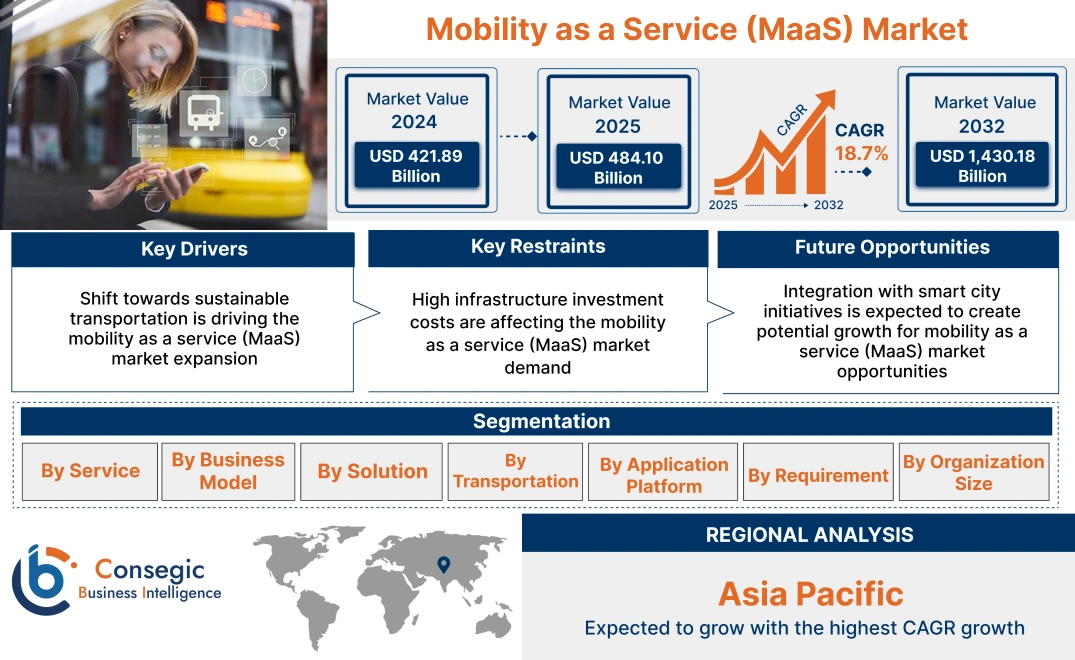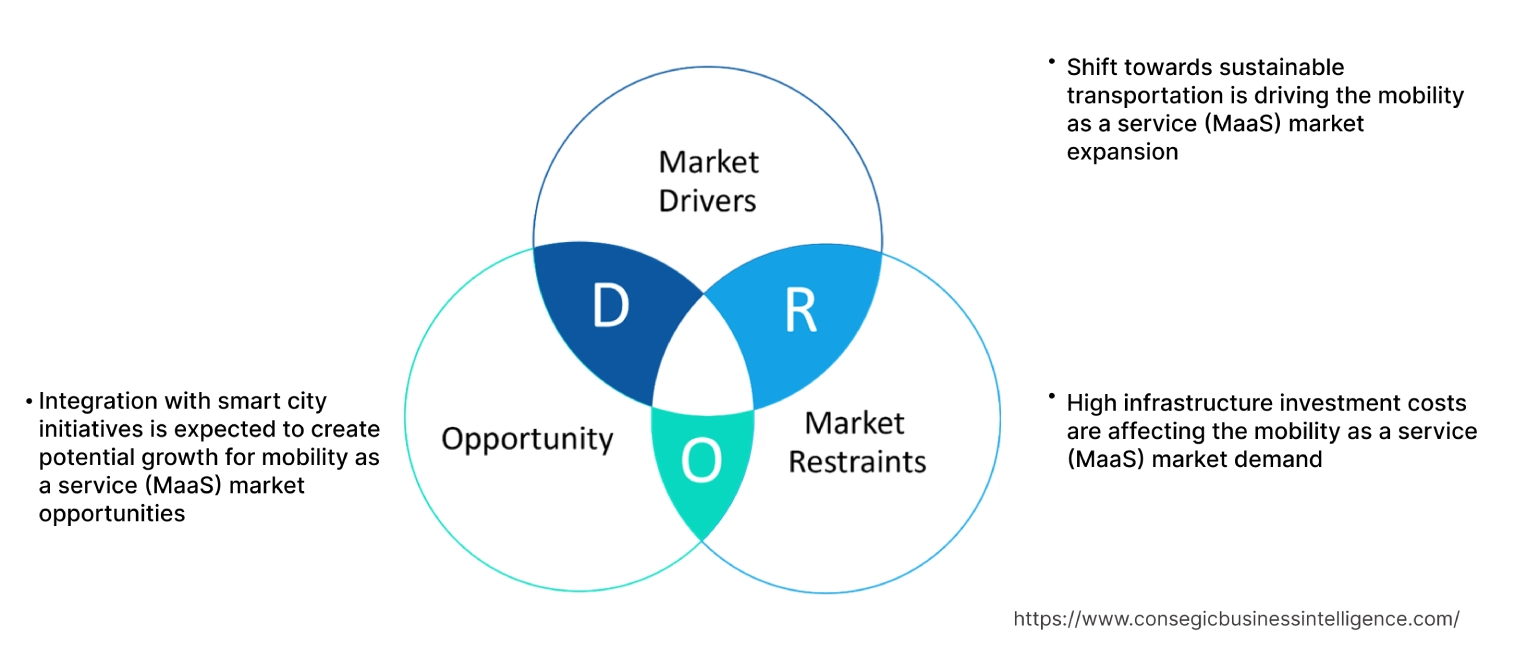- Summary
- Table Of Content
- Methodology
Mobility as a Service (MaaS) Market Size:
Mobility as a Service (MaaS) Market Size is estimated to reach over USD 1,430.18 Billion by 2032 from a value of USD 421.89 Billion in 2024 and is projected to grow by USD 484.10 Billion in 2025, growing at a CAGR of 18.7% from 2025 to 2032.
Mobility as a Service (MaaS) Market Scope & Overview:
Mobility as a Service (MaaS) represents a shift from personally owned modes of transportation to accessing mobility solutions on-demand through a unified platform. MaaS integrates various forms of transport services, including public transit, ridesharing, bike-sharing, car-sharing, and even micro-mobility options like electric scooters, into a single accessible service. This convergence aims to provide users with seamless and convenient travel experiences, reducing the dependency on private vehicle ownership and promoting sustainable urban mobility.
Key Drivers:
Shift towards sustainable transportation is driving the mobility as a service (MaaS) market expansion
As environmental concerns rise and urbanization increases, there's a growing emphasis on reducing carbon emissions and mitigating traffic congestion. MaaS offers a holistic approach by integrating various transportation services into a single platform, allowing users to seamlessly plan, book, and pay for their journeys using a combination of public transit, ridesharing, biking, and walking options. This shift towards MaaS aligns with the broader need for sustainability and presents a compelling solution to address the challenges associated with traditional car-centric mobility models. Additionally, government initiatives aimed at promoting sustainable transportation and reducing reliance on private car ownership are further fueling the need for MaaS solutions. In many urban centers, policymakers are incentivizing the use of shared mobility services and investing in infrastructure to support alternative modes of transportation.
- For instance, in September 2024, Societe Generale Real Estate division announced the involvement of promotion of low-carbon transportation. This includes traditional and electric bikes, electric unicycles, and scooters. In addition to this, the company is also offering car-sharing services for both personal and professional use, while reducing carbon emissions associated with daily commuting.
Thus, according to the mobility as a service market analysis, the shift towards sustainable transportation is driving the mobility as a service (MaaS) market size.
Key Restraints:
High infrastructure investment costs are affecting the mobility as a service (MaaS) market demand
Initial infrastructure investment costs play a pivotal role in shaping the global market landscape. At the initial phase, substantial capital expenditure is required to establish the foundational elements of MaaS ecosystems, including digital platforms, connectivity infrastructure, and vehicle fleets. This initial investment burden can hamper for market entry, particularly for smaller players or startups.
Moreover, the need for interoperability and seamless integration across various transportation modes adds complexity and cost to the infrastructure development phase.Thus, the above analysis depicts that the aforementioned factors would further impact on mobility as a service (MaaS) market size.
Future Opportunities :
Integration with smart city initiatives is expected to create potential growth for mobility as a service (MaaS) market opportunities
As cities cope with issues such as traffic congestion, pollution, and limited parking space, MaaS emerges as a complete approach that combines various transportation modes into a single, accessible platform. Smart city initiatives aim to leverage technology to enhance urban living, which naturally align with the principles of MaaS by emphasizing data-driven decision-making and seamless connectivity. Further, by leveraging advanced technologies such as artificial intelligence, Internet of Things (IoT), and blockchain, MaaS platforms can offer real-time traffic updates, predictive analytics, and seamless payment solutions while enhancing the overall user experience. Moreover, the integration of MaaS with smart city initiatives fosters sustainable transportation practices, reducing carbon emissions, and promoting the use of alternative modes such as electric vehicles and public transit.
- For instance, in March 2025, Rochester-Genesee Regional Transportation Authority (RGRTA) announced the partnership with The Routing Company, to launch on-demand transit services in North America. The service includes micro transit and deviated route services, which operated from seven counties, including Livingston, Ontario, Wyoming, Wayne, Genesee, Seneca, and Orleans.
Thus, based on the above mobility as a service market analysis, the growing smart cities initiatives are expected to drive mobility as a service (MaaS) market opportunities.
Mobility as a Service (MaaS) Market Segmental Analysis :
By Service:
Based on service, the mobility as a service (MaaS) market is segmented into ride hailing, car sharing, micro mobility, bus sharing, and train services.
Trends in service:
- The growing population in urban areas increased the necessity for innovative, technological solutions, making MaaS a key factor in driving the landscape of urban transportation.
- Integrating mobility as a service in travel sector allows travel agencies to enhance their operational efficiency and provide customers with multimodal options, while increasing customer satisfaction and loyalty.
The ride hailing segment accounted for the largest revenue in the year 2024.
- The accessibility and affordability of ride-hailing services have been available to all types of transportation, while providing alternatives to traditional taxi services and public transit while addressing last-mile connectivity challenges in urban and suburban areas.
- Advancements in areas such as autonomous vehicles, electric mobility, and multimodal transportation are reshaping the future of ride-hailing, offering prospects for market differentiation and innovation.
- For instance, in November 2022, Lyft announced the partnership with Motional, to launch robotaxis in Los Angeles, U.S. The robotaxi encompassed Motional’s fleet Hyundai Ioniq 5 electric vehicles, which are fully autonomous and does not require a human to drive it.
- Thus, based on the above analysis, these factors are further driving the mobility as a service (MaaS) market growth.
The car sharing segment is anticipated to register the fastest CAGR during the forecast period.
- As populations concentrate in urban centers and transportation infrastructure evolves, there is an increasing need for convenient and flexible mobility options. Car sharing and leasing services cater to this need by providing access to vehicles on a temporary basis, offering an alternative to traditional ownership models.
- Digital platforms, mobile apps, and telematics systems have transformed the way customers interact with car sharing providers, making reservation, booking, and vehicle management processes more convenient and efficient.
- For instance, in November 2024, Zoomcar Holdings, Inc. introduced Zoomcar subscription, to provide long term car sharing options. With this offering, users can book cars for extended periods, starting with minimum 7 days.
- Thus, based on the above analysis, these factors are expected to drive the mobility as a service (MaaS) market share during the forecast period.
By Business Model:
Based on business model, the mobility as a service (Maas) market is segmented into B2B, B2C, and P2P.
Trends in business model:
- Consumers are increasingly seeking flexible and cost-effective mobility solutions. They are shifting towards on-demand services to address the needs of commuters, who are seeking reliable mobility services.
- Several business models in mobility services reduce transportation costs through optimized routes, shared mobility, and efficient fleet management.
The B2C segment accounted for the largest revenue in the year 2024.
- Business-to-consumer mobility service offers individuals convenient, on-demand transportation options, eliminating the need for personal vehicle ownership.
- This model thrives in urban areas where parking is scarce, making it a more practical option than owning a car.
- B2C platforms are increasingly integrating diverse transportation options, including, car sharing, ride hailing, bike sharing, scooter rentals, and public transit. This allows consumers to plan and execute seamless and multimodal journeys.
- Thus, based on the above analysis, these factors would further supplement the global market share.
The B2B segment is anticipated to register the fastest CAGR during the forecast period.
- Corporations and institutions are driving the need for B2B mobility solutions, seeking efficient travel options that maximize workforce productivity.
- MaaS platforms provide a centralized access point to various transportation modes, allowing business travellers to optimize their time.
- For instance, in February 2025, Aravam Tech launched B2B ride management platform, Triptronic. The app will be accessible on subscription basis for transport services, where it is utilized by cab vendors as well as employees.
- These developments in the mobility industry are anticipated to further drive the mobility as a service (MaaS) market trends during the forecast period.
By Solution:
Based on solution, the mobility as a service (MaaS) market is segmented into technology platforms, payment engines, navigation solution, telecom connectivity providers, and insurance services.
Trends in solution:
- MaaS offers a solution by optimizing existing transportation infrastructure and leveraging digital platforms to provide efficient, affordable, and environmentally friendly mobility services to urban dwellers.
- Mobile applications and online platforms have made it easier for users to access and pay for transportation services, plan multi-modal journeys, and receive real-time updates on transit options. These innovations are resulting in market growth across solution segment.
The technology platforms segment accounted for the largest revenue share of 30.86% in the year 2024.
- Technology platforms serve as the backbone of MaaS ecosystems, integrating diverse transportation modes into seamless, user-friendly interfaces. These platforms enable users to plan, book, and pay for multi-modal journeys conveniently, fostering the shift towards sustainable and efficient transportation options.
- Further, cloud-based platforms effectively and efficiently manage the substantial data, which is generated by mobility as a service application, while ensuring scalability and robust data security measures.
- For instance, in December 2023, May Mobility introduced fully driverless service platform in Arizona. This deployment offers autonomous transportation without a driver, while providing advancements in autonomous technology with the mobility sector.
- Thus, based on the above analysis, these developments in the technology segment are driving the mobility as a service (MaaS) market growth.
The payment engines segment is anticipated to register the fastest CAGR during the forecast period.
- Payment engines offer secure and efficient transaction processing capabilities. As MaaS continues to gain traction, streamlined payment processes are essential to enhance user experience and encourage broader adoption.
- The payment solutions are designed to include multi-currency support, while ensuring compatibility with tourist and travellers from various regions.
- The payment solutions integrate transportation services into packages, offering users different modes of transportation at a discounted price.
- These developments in the payment engines segment are anticipated to further drive the mobility as a service (MaaS) market trends during the forecast period.
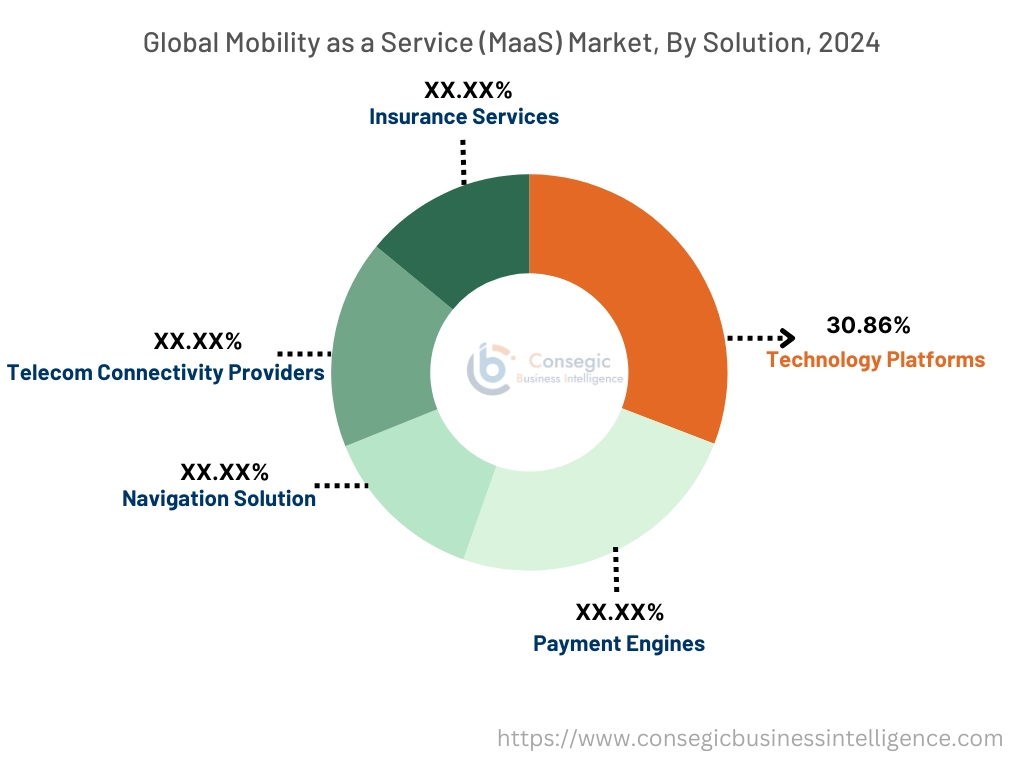
By Transportation:
Based on transportation, the mobility as a service (MaaS) market is segmented into private and public.
Trends in transportation:
- Tourists often prefer the flexibility and convenience of renting a vehicle to explore various attractions and destinations at their own pace. As international travel continues to rise and travelers seek immersive experiences, the need for public and private transportation in tourist hotspots is expected to remain strong, fueling growth in the global market.
- By integrating car-sharing, ride-hailing, or subscription-based models into their existing platforms, rental companies can offer customers a more comprehensive range of transportation options.
The public segment accounted for the largest revenue in the year 2024.
- MaaS integrates various modes of public transit, such as buses, trains, and subways, into a seamless and interconnected system accessible through a single platform or application. This integration aims to enhance the efficiency and convenience of public transit, encouraging greater utilization and reducing reliance on individual car ownership.
- Additionally, advancements in technology, such as real-time tracking and payment systems, further streamline the user experience, making public transportation more appealing and accessible to a broader consumer base.
- For instance, in September 2023, Brussels City government launched Floya, a mobility service application, to allow residents access transportation solutions and services all in one place. It includes bike sharing, ride-hailing services, and public transit services. These services streamline urban mobility and promote the use of sustainable transportation solutions in the city.
- Thus, based on the above factors, these developments in the public segment are driving the mobility as a service (MaaS) market demand.
The private segment is anticipated to register the fastest CAGR during the forecast period.
- Private vehicle booking through mobility services allows users to access on-demand transportation, while maintaining the convenience and familiarity of their vehicles.
- These services offer consumers greater flexibility and convenience compared to traditional public transit options, allowing them to access transportation on-demand and tailor their journeys to specific needs and preferences.
- These developments in the private segment are anticipated to further drive the mobility as a service (MaaS) market expansion during the forecast period.
By Application Platform:
Based on application platform, the market is segmented into IOS, android, and others.
Trends in application platform:
- By embracing digital technology platforms, the smart urban ecosystem has the potential to create more streamlined and readily accessible transportation networks.
- The integration of mobility services with different application platforms allows companies to adapt to changing customer behaviours, preferences, urban mobility developments, ensuring long-term sustainability.
The android segment accounted for the largest revenue in the year 2024 and it is expected to register the highest CAGR during the forecast period.
- Android being an open-source platform, offers a vast array of devices across different price points. The platform flexibility and customization options make it suitable choice for both users and developers.
- Android devices offer a user-friendly experience and extensive app ecosystem for mobility service applications.
- Android platforms are essential for mobility as a service (MaaS) providers to reach a broad audience and maximize market penetration. This requires investment in app development, optimization, and maintenance for both operating systems.
- Additionally, it presents an opportunity for partnerships and collaborations with smartphone manufacturers to ensure seamless integration and interoperability of mobility solutions across devices.
- Thus, based on the above mobility as a service (MaaS) market analysis, these developments in the android segment are driving the global market.
By Requirement:
Based on requirement, the market is segmented into first & last mile connectivity, off-peak & shift work commute, daily commuter, airport or mass transit stations trips, inter-city trips, and others.
Trends in requirement:
- MaaS represents a paradigm shift in how people perceive and utilize transportation services by offering a seamless and integrated approach to mobility. This approach integrates various modes of transportation into a single platform accessible through a smartphone app or a web interface.
- By offering personalized and context-aware transportation options, the service providers meet the evolving need of commuters, driving the need for mobility solutions that prioritize efficiency, convenience, and user-centricity.
The first & last mile connectivity segment accounted for the largest revenue share in the year 2024 and it is expected to register the highest CAGR during the forecast period.
- Micro-mobility solutions, such as electric scooters and bikes, offer a convenient and quick escape from traffic, making commutes faster and easing congestion.
- Platforms such as Zipcar, Car2Go, and Turo enable users to access vehicles on an as-needed basis, typically through membership-based programs or smartphone apps. These services promote sustainability, resource efficiency, and urban mobility by reducing the number of privately owned vehicles on the road and encouraging shared utilization of existing vehicle fleets.
- Ride-hailing companies offer van or bus services for group travel, corporate shuttles, event transportation, or tourist excursions, providing efficient and cost-effective mobility solutions for larger passenger capacities.
- For instance, in December 2022, Moovit launched a new urban mobility app in Tampa, enable users to plan multimodal trips seamlessly. The app helps user plan trips, for biking, scooters, walking, and driving. The app also offers mobile ticketing for public transit and real-time arrival information, while providing reliable urban mobility information.
- Thus, based on the above mobility as a service (MaaS) market analysis, these developments in the first and last mile segment are driving the global market.
By Organization Size::
Based on organization size, the market is segmented into large enterprises and SME.
Trends in organization size:
- Mobility services help organizations reduce the need for company cars, leading to lower maintenance, insurance, fuel, and depreciation costs.
- By offering various options and real-time information, mobility services help reduce commute-related stress and improve employee satisfaction.
The large enterprises segment accounted for the largest revenue in the year 2024.
- In large enterprises, MaaS platforms provide valuable data and insights into employee travel patterns, while allowing them to optimize their mobility operations and make informed decisions.
- Corporate mobility as a service (CMaaS) focuses on integrating company exclusive fleets and public mobility services into one multimodal mobility system. This allows employees to access a variety of mobility options, such as company-owned vehicles, bike-sharing, and ridesharing.
- Thus, based on the above factors, these developments in the large enterprises segment are driving the global market.
The SME segment is anticipated to register the fastest CAGR during the forecast period.
- By providing a centralized platform for booking and managing transportation, mobility services streamline travel arrangements for employees, saving time and resources in SEMs.
- Small businesses can leverage MaaS to manage transportation for field service personnel or logistics operations, ensuring efficient and reliable delivery of goods and services.
- These factors are anticipated to further drive the global market during the forecast period.
Regional Analysis:
The regions covered are North America, Europe, Asia Pacific, the Middle East and Africa, and Latin America.
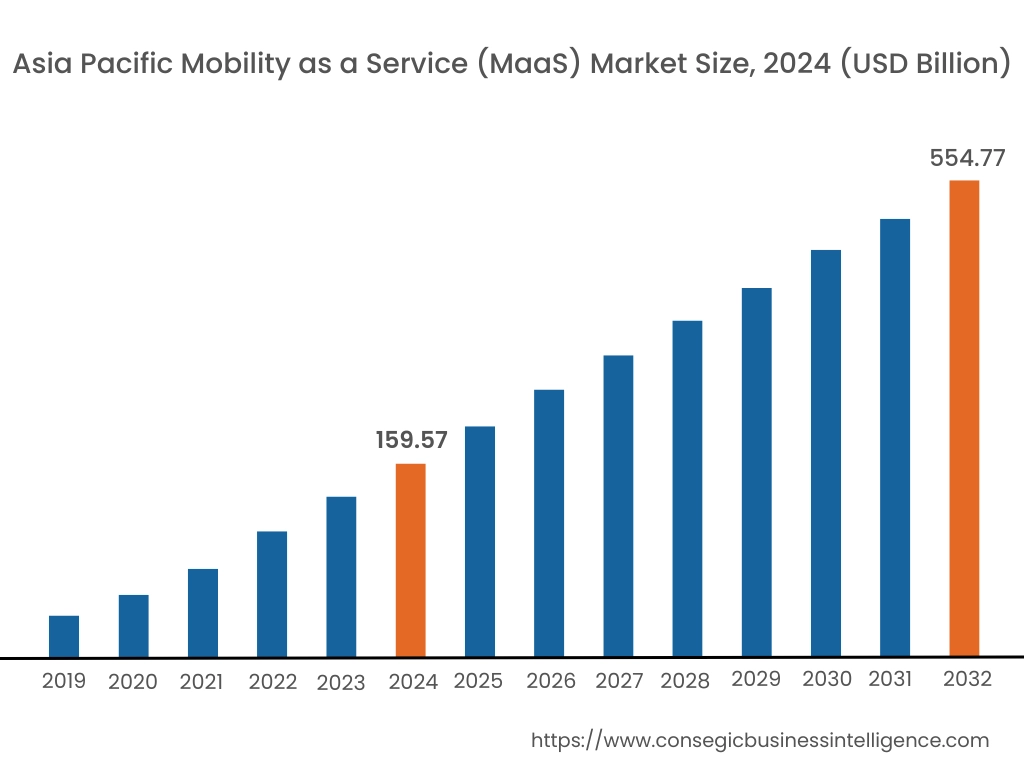
Asia Pacific mobility as a service market expansion is estimated to reach over USD 554.77 billion by 2032 from a value of USD 159.57 billion in 2024 and is projected to grow by USD 183.49 billion in 2025. Out of this, the China market accounted for the maximum revenue split of 35.29%. Asia Pacific is emerging as a significant market for mobility as a service, driven by rapid urbanization, along with rising disposable incomes and increasing travel need, which are driving the adoption of mobility services across the region. As urban centers expand and populations grow, the need for flexible transportation options is also growing, creating lucrative prospects for service providers to offer innovative solutions tailored to the diverse needs of consumers in this region. Further, governments in countries such as China, Japan, and South Korea are actively promoting MaaS initiatives to address traffic congestion and pollution challenges. These factors would further drive regional mobility as a service (MaaS) market share during the forecast period.
- For instance, in February 2025, UNL announced the collaboration with GrabMaps, to provide next-generation location solutions for Southeast Asia. With this strategic partnership, Southeast Asian developers and businesses enable their hyperlocal location applications and services using GrabMaps location data and UNL’s pixel-based mapping & location technology.
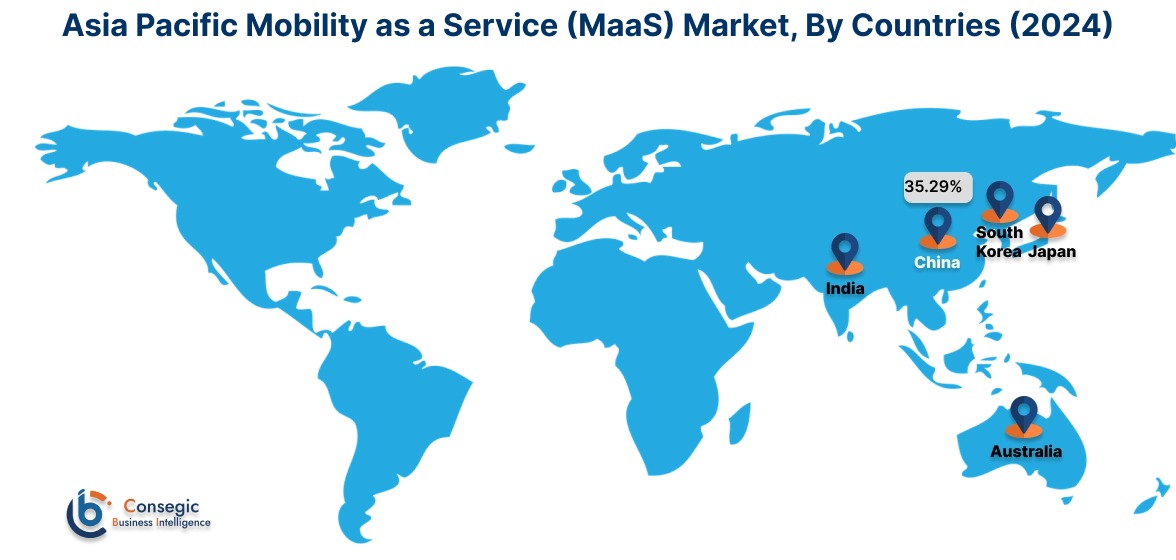
North America market is estimated to reach over USD 383.29 billion by 2032 from a value of USD 113.92 billion in 2024 and is projected to grow by USD 130.63 billion in 2025. The region has a robust digital infrastructure, characterized by high smartphone penetration and advanced internet connectivity, enabling the swift adoption of mobility services that provide access to various mobility services, such as ride-hailing, bike-sharing, and public transit. North American firms are leading the integration of cutting-edge technologies into mobility services and solutions. Further, major players such as Uber and Lyft have enhanced their platforms with features like real-time tracking, dynamic pricing, and seamless payment options. Moreover, the emergence of autonomous vehicles, with companies like Waymo is opening new possibilities for urban transportation. These factors would further drive the mobility as a service (MaaS) in the regional market.
- For instance, in April 2021, Car Trawler announced the partnership with Uber, to bring Uber Rent to more customers in U.S. With this collaboration, Uber apps users can access to quality car rentals at competitive rates. In addition to this, CarTrawler’s technology facilitates renting options through an accessible offering and provide promotions, such as Uber Cashback offers.
Additionally, according to the analysis, the mobility as a service (MaaS) industry in Europe is projected to witness significant development during the forecast period. With progressive regulatory frameworks and extensive public transportation networks, European countries embraced mobility as a service (MaaS) platforms to enhance urban mobility and reduce carbon emissions. Moreover, the presence of established players and innovative startups within the region fosters competition and innovation, driving the growth of the market across Europe.
Additionally, in Latin America, the governments are actively promoting mobility services through different policies, funding, and partnerships to reduce traffic congestion and lower carbon emissions. Further, factors such as infrastructure development, tourism growth, and rising consumer mobility contribute to the growing need for rental vehicles in the MEA region. As the MEA economy continue to develop and urbanize, the mobility services are expected to play a crucial role in meeting the transportation needs of consumers.
Top Key Players and Market Share Insights:
The global mobility as a service (MaaS) market is highly competitive with major players providing services to the national and international markets. Key players are adopting several strategies in research and development (R&D), product innovation, and end-user launches to hold a strong position in the market. Key players in the mobility as a service (MaaS) industry include-
- Uber Technologies Inc. (U.S.)
- Movmi Shared Transportation Services Inc. (U.S.)
- MOBIKO (Germany)
- Lyft, Inc. (U.S.)
- HERTZ SYSTEM, INC. (U.S.)
- Europcar (France)
- Curb Mobility (U.S.)
- Careem (UAE)
- Beijing Xiaoju Technology Co., Ltd. (China)
- Roppen Transportation Services (India)
Recent Industry Developments :
Expansion:
- In March 2025, Roppen Transportation Services (Rapido) announced that it would expand its services in 500 cities of India. With this development, the mobility service provider will provide greater accessibility, convenience, and affordability to users across all the cities.
Mobility as a Service (MaaS) Market Report Insights :
| Report Attributes | Report Details |
| Study Timeline | 2019-2032 |
| Market Size in 2032 | USD 1,430.18 Billion |
| CAGR (2025-2032) | 18.7% |
| By Service |
|
| By Business Model |
|
| By Solution |
|
| By Transportation |
|
| By Application Platform |
|
| By Requirement |
|
| By Organization Size |
|
| By Region |
|
| Key Players |
|
| North America | U.S. Canada Mexico |
| Europe | U.K. Germany France Spain Italy Russia Benelux Rest of Europe |
| APAC | China South Korea Japan India Australia ASEAN Rest of Asia-Pacific |
| Middle East and Africa | GCC Turkey South Africa Rest of MEA |
| LATAM | Brazil Argentina Chile Rest of LATAM |
| Report Coverage |
|
Key Questions Answered in the Report
How big is the Mobility as a Service (MaaS) Market? +
Mobility as a Service (MaaS) Market Size is estimated to reach over USD 1,430.18 Billion by 2032 from a value of USD 421.89 Billion in 2024 and is projected to grow by USD 484.10 Billion in 2025, growing at a CAGR of 18.7% from 2025 to 2032.
Which is the fastest-growing region in the Mobility as a Service (MaaS) Market? +
Asia-Pacific is the region experiencing the most rapid growth in the market.
What specific segmentation details are covered in the Mobility as a Service (MaaS) report? +
The mobility as a service report includes specific segmentation details for service, business model, solution, transportation, application platform, requirement, organization size, and region.
Who are the major players in the Mobility as a Service (MaaS) Market? +
The key participants in the market are Uber Technologies Inc. (U.S.), Movmi Shared Transportation Services Inc. (U.S.), MOBIKO (Germany), Lyft, Inc. (U.S.), HERTZ SYSTEM, INC. (U.S.), Europcar (France), Curb Mobility (U.S.), Careem (UAE), Beijing Xiaoju Technology Co., Ltd. (China), Roppen Transportation Services (India), and others.
